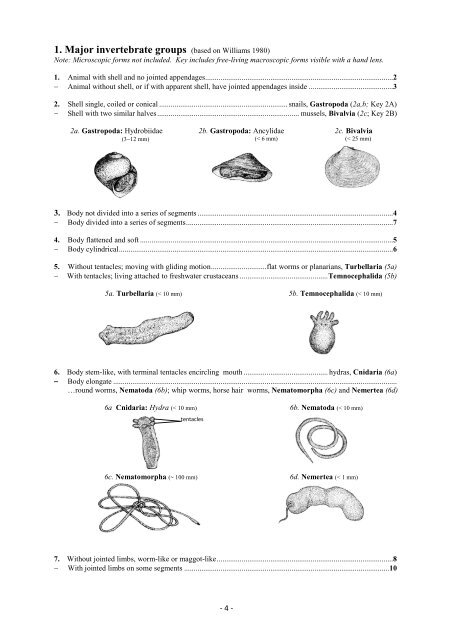Guide riffle invertebrates Australian Wet Tropics streams
1709Guidetotheriffleinvertebrates
1709Guidetotheriffleinvertebrates
Create successful ePaper yourself
Turn your PDF publications into a flip-book with our unique Google optimized e-Paper software.
1. Major invertebrate groups (based on Williams 1980)<br />
Note: Microscopic forms not included. Key includes free-living macroscopic forms visible with a hand lens.<br />
1. Animal with shell and no jointed appendages ..................................................................................................2<br />
− Animal without shell, or if with apparent shell, have jointed appendages inside ............................................3<br />
2. Shell single, coiled or conical ................................................................... snails, Gastropoda (2a,b; Key 2A)<br />
− Shell with two similar halves .......................................................................... mussels, Bivalvia (2c; Key 2B)<br />
2a. Gastropoda: Hydrobiidae<br />
(3−12 mm)<br />
2b. Gastropoda: Ancylidae<br />
(< 6 mm)<br />
2c. Bivalvia<br />
(< 25 mm)<br />
3. Body not divided into a series of segments ......................................................................................................4<br />
− Body divided into a series of segments ............................................................................................................7<br />
4. Body flattened and soft ....................................................................................................................................5<br />
− Body cylindrical ...............................................................................................................................................6<br />
5. Without tentacles; moving with gliding motion ............................. flat worms or planarians, Turbellaria (5a)<br />
− With tentacles; living attached to freshwater crustaceans .............................................. Temnocephalida (5b)<br />
5a. Turbellaria (< 10 mm) 5b. Temnocephalida (< 10 mm)<br />
6. Body stem-like, with terminal tentacles encircling mouth ............................................ hydras, Cnidaria (6a)<br />
− Body elongate ....................................................................................................................................................<br />
…round worms, Nematoda (6b); whip worms, horse hair worms, Nematomorpha (6c) and Nemertea (6d)<br />
6a Cnidaria: Hydra (< 10 mm)<br />
tentacles<br />
6b. Nematoda (< 10 mm)<br />
6c. Nematomorpha (~ 100 mm) 6d. Nemertea (< 1 mm)<br />
7. Without jointed limbs, worm-like or maggot-like ............................................................................................8<br />
− With jointed limbs on some segments ........................................................................................................... 10<br />
- 4 -


